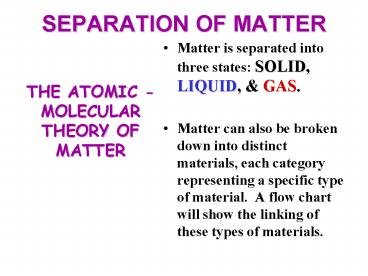SEPARATION OF MATTER - PowerPoint PPT Presentation
Title:
SEPARATION OF MATTER
Description:
A flow chart will show the linking of these types of materials. ... writing with pencil _ snowing. HO. E. E. C. HO. HE. HE. HO. Homogeneous mixture. CC. PC. CC. PC ... – PowerPoint PPT presentation
Number of Views:47
Avg rating:3.0/5.0
Title: SEPARATION OF MATTER
1
SEPARATION OF MATTER
- Matter is separated into three states SOLID,
LIQUID, GAS. - Matter can also be broken down into distinct
materials, each category representing a specific
type of material. A flow chart will show the
linking of these types of materials.
THE ATOMIC - MOLECULAR THEORY OF MATTER
2
The Atomic-Molecular Theory of Matter
Separated by physical methods
Separated by physical methods
Separated by physical methods
Separated by chemical methods
3
The Atomic-Molecular Theory of Matter
4
The Atomic-Molecular Theory of Matter A
microscopic view
5
The Atomic-Molecular Theory of Matterdefinitions
- Matter occupies space and has weight.
- Energy the ability to do work
- Materials a particular type of matter, generic
term. - Mixture has variable composition, can be
separated by physical methods. - Heterogeneous mixture has properties which vary
from region to region, can be separated into a
homogeneous mixture or a substance. - Homogeneous mixture uniform properties
throughout, also called a solution. Can be
separated into substances.
6
The Atomic-Molecular Theory of Matter
- Physical properties characteristics of a
material which may be determined without altering
the composition of the material bp (boiling
point), mp, color, density etc., no change in the
chemical identity occurs. - Chemical properties characteristics of a
material which involves altering the composition
of the material, the ability to form new
substances by decomposition or reactions with
other substances. A rearrangement of the atoms.
- Phase a sample of matter that is uniform
throughout, both in its chemical composition and
its physical state. - Chemical Bonds the attractive forces, the
glue, strong enough to maintain a group of atoms
together for an indefinite amount of time.
7
- Chemical structure the position and geometry
of the atoms in a molecule.
8
The Atomic-Molecular Theory of Matter
- (Pure) substance a material which can not be
separated by physical methods into 2 or more
materials which have different characteristics. - Compounds a material containing two or more
elements or molecules. - Molecules the smallest grouping which a
substance can be divided into without forming a
new substance, a group of 2 or more atoms held
together by strong forces called "bonds". - Atoms the smallest particle of matter which has
distinctive chemical characteristics, generic
term, composed of a nucleus surrounded by
electrons. - Elements a specific substance which can not be
decomposed into simpler substances by chemical
means, an atom with a specific number of protons,
neutrons, and electrons.
9
The Atomic-Molecular Theory of Matter
- Nucleus the small positively charged kernel,
composed of protons and neutrons. - Protons a positively charged particle, has a
mass 1.67 x 10-27 kg or 1 amu (atomic mass
unit) usually symbolized as H or p. - Neutrons neutral particles with the same mass as
the proton, contributes weight but no charge. - Electrons a negatively charged particle, has a
mass 9.1 x 10-31 kg (1/1837 amu) usually
symbolized as e-.
10
YES
NO
YES
NO
YES
NO
11
(No Transcript)
12
PRACTICE PROBLEMS 4
- 1. Classify the following as an element,
compound, or mixture (heterogeneous or
homogeneous). - _____ air _____ oxygen
- _____ tin can _____ sugar
- _____ Windex _____ crude oil
- _____ suntan lotion _____ gummi bear
- 2. A white solid is dissolved in water. The
resulting colorless, clear liquid is boiled in a
beaker until dryness. White crystals remain in
the beaker. The liquid can be classified as
a(n) ______________. - 3. Classify the following as physical or
chemical changes. - _____ photosynthesis _____ baking
- _____ writing with pencil _____ snowing
E
HO
E
C
HE
HO
HE
HO
Homogeneous mixture
CC
CC
PC
PC































